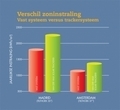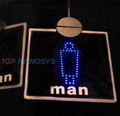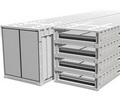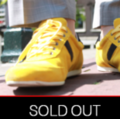Top 10 Green Architecture Projects of 2011
by: Ecofriend, 2011-09-21 10:28:04 UTC
Payal Chatterjee:

Green Architecture Projects of 2011introductory picture
We’ve always believed that green architecture can revolutionize the urbanities of tomorrow, making them sustainable and reducing their carbon footprint. Architects over the globe have been working hard to design futuristic architecture designs, which will change the face of urban planning forever. While some of these designs are too complex to be built anytime soon, there are few designs that have already taken shape and are showing glimpses of the future of sustainable building. Here are ten of the best eco friendly architecture designs that took shape this year.
Here is a list of green architecture projects that protects and enhances our environment.
1. Cherokee Studio, Los Angeles, CA

Cherokee Studio, Los Angelesa green urban housing project
The Brooks+Scarpa’s Cherokee Studio in LA are urban apartments that have been designed to be energy-efficient at the same time. The use of passive cooling strategy like thermal convection and cross-ventilation is perfect for its sunny Southern California location. Awaiting the LEED Platinum certification, it also features a double facade system with metal shade screens that the owner can control and operate.
2. First Unitarian Society Meeting House, Madison, WI

First unitarian Society Meeting Housea green architecture in Madison, WI
The growth in the congregation of the First Unitarian Society, demanded its need to expand in order to accommodate each and every member of the congregation. However, they wished to expand as well as maintain the integrity of Frank Lloyd Wright’s original design. This 20,000 sq ft expansion consists a 500 seat auditorium along with meeting, office, fellowship, kitchen and music rehearsal area. It is a contemporary architecture reflecting Wright’s concept of Organic Architecture.
3. Lance Armstrong Foundation Headquarters

Lance Armstrong Foundation Headquartersa green architecture
Designed by the Lake Flato Architects and The Bommarito Group, the Lance Armstrong Foundation Headquarters is located in Austin, Texas, USA. Submitted for the LEED Gold certification, this architectural project will not only breathe energy into the building, but also its surrounding. On opening the roof and the facade, the interior gets flooded with natural light. It provides meeting rooms, dinning facilities, office space, open-air courtyard, an in-house gym and also parking area for staffs.
4. Kiowa County K-12 Schools, Greensburg, KS

Kiowa County K-12 schoolgreen architecture
Targeting LEED Platinum certification, the Kiowa County K-12 schools in Greensburg, Kansas, is designed with the intention of making Greensburg a eco-community. It can accommodate 375 students and consists of several iTV classrooms, cafeteria, a stadium track and two gyms.
5. LOTT Clean Water Alliance, Olympia, WA

LOTT Clean Water AllianceGreen architecture
Designed by Miller Hull Partnership, the LOTT Clean Water Alliance Regional Service Centre is a LEED Platinum certified architecture. The reclaimed water is used for a pond around the centre, the building’s green roof, for irrigating the grounds and for flushing the toilets inside the building.
The project uses recyclable products like reused timber from a demolished port warehouse, natural sunlight inside the building and also external louvers to control the heat of the sun in order to reduce the use of air conditioners.
6. LIVESTRONG Foundation, Austin, TX

LIVESTRONG FoundationGreen architecture in Austin, TX
The new LIVESTRONG Foundation is an adaptive reuse project built in the place of a former paper factory in Austin, Texas. The project is a green architecture project as it involves the use of reclaimed materials for building this new building. It also consists of creative office spaces and the use of natural light helps in conserving electric energy too.
7. High Tech High, Chula Vista, CA

High Tech Highin Chula Vista, CA
The 45,000 sq ft High Tech High School has been designed by Studio e Architects and can accommodate around 450 students. It is situated in southeastern Chula Vista on an 8 acre sight overlooking the Otay River valley and Mexico in the south. The buildings capture solar energy for maximum usage at the same time taking advantage of the cooling breezes. The buildings are also perforated with courtyards for cross-ventilation and daylighting with southward sloping roofs to maximise solar exposure.
8. Vancouver Convention Centre West, Vancouver, British Columbia

Vancouver Convention Centre Westgreen architecture
The LEED Platinum certified Vancouver Convention Centre is famous for its huge green roof. It is situated on Vancouver’s waterfront and has been designed to balance the ecology and the local environment and culture. The 6 acre green roof houses around 400,000 native plants, 240,000 bees and acts as an insulator in controlling the external temperature. It also integrates with the waterfront ecosystem and helps in the building’s stormwater use. The building also helps in conserving drinking water with an in-built waste water treatment plant. An underwater artificial reef provides home to mussels, barnacles, crabs, starfish and several other marine species.
9. Set Up on 5th, Santa Monica, CA

Set Up on 5thgreen architecture
Set Up on 5th in Santa Monica is a mixed-use project that provides houses, support services and also a rehabilitation home mentally disabled and homeless people. There are 46 affordable studio apartments with the ground level for commercial use. Custom water jet-anodized aluminium panels on the front side of the building act as sun protector as well as privacy screen while the south-facing walls filter direct sunlight. The design and planning of Set Up on 5th involves certain solar design strategies like orienting and shaping the building for exposure to prevailing winds, orienting and locating the building to control solar cooling loads, designing windows to increase the amount of daylight entering inside, shading the south facing windows, maximizing natural ventilation through windows and designing interiors to increase the inflow of air and sunlight. Several recycled and energy saving materials have been used to build the building.
10. OS House, Racine, WI

OS Housegreen architecture
Located in Racine, Wisconsin, this LEED Platinum certified urban home is a small sustainable residence built with moderate budget. It occupies a narrow infill lot along the edge of Lake Michigan and cuts out on extra bathrooms, closet space and parking spaces in order to increase the floor space.


 Top 7 green products to buy in 2011
Top 7 green products to buy in 2011
by: Ecofriend, 2011-09-21 10:37:18 UTC
Radhicka S Saxena:

Green ProductsGreen Products are beneficial for the environment
Going green is not easy, you have to embrace it with all your heart and adopt it in every sphere of your life. Sure we do our best to conserve energy and preserve the environment like switching off lights when not needed, swapping paper bags with plastic ones, planting trees, etc. Despite this our lifestyle practices can harm the earth immensely. We continue to use several environment damaging products every day.
Foods and personal care products are laced with harmful chemicals. Appliances used add to the energy load. Changing our mundane habits and everyday living actions can make a difference and contribute tremendously to ecological sustenance. Let’s take a look at a few ecofriendly products that have hit the market in 2011.
1. Beautify with EcoTools
Fashionistas can also do their bit for mother earth. Many personal care products and cosmetics are being manufactured keeping the green theme in mind. One such range of cosmetics is EcoTools that offers brushes, bath tools, carrier bags for cosmetics, etc. The products are made from materials like recycled aluminum, bamboo, natural loofah, cotton, ramie, recycled plastic netting, etc and are also paraben and phthalate free. The newest addition is a cosmetic bag of natural hemp and cotton blend containing a makeup case and brushes designed by the Hollywood heartthrob Alicia Silverstone.
2. Clean and Green
All housewives who want to chip in on the green movement need not wait any longer. If you cant take time out of your busy chores, just purchase some green products for cleaning and sprucing up your home. Introduced by Clorox, Green works is a line of efficient cleaners manufactured from natural plant and mineral based ingredients that do not contain any harsh chemicals.
3. Eco Savvy Fashion
There are many organic fashion labels in the market like and many big brands are also going green. Conscious Collection by H&M is made using earth friendly fabrics like cotton, linen, recycled polyester, and Tencel which is biodegradable cellulose derived from wood pulp. Hemp and recycled rubber foot wear and bags have been unveiled by Zoe&Zac. Even Levi Strauss & Co. has come up with WaterLess Jeans that uses atleast 28% less water and is made with organic cotton and natural indigo dyes.
4. Earthy love for your baby
Although cloth diapers are known to be the eco friendly alternative, there is yet another solution for eco conscious moms out there. Ordinary plastic diapers are a big part of non biodegradable waste that is thrown out in trash and pollutes the earth. With gDiapers this risk is eliminated as the inner lining of the can be flushed and becomes a part of the sewage and not trash that pollutes the land. Also, their colored outer cover can be reused several times.
5. Philips Eco TV
LCD Tvs are a visual delight but consume a lot of power. However, Eco Tv from Philips consumes less power than any other HDTV. This is made possible due to a backlight mounted on the TV which dims the light output of the device during dark scenes. This does affect picture quality to some extent but the difference goes mostly unnoticed.
6. Solar Charger
A stylish design that is compatible with more than 3000 devices and can power up any gizmo that is connected to it via the USB cable like cell phones, e-readers, mp3 players, cameras, etc. It has rotating solar panels and can be charged from the sun, wall or through a USB. A pencil can be inserted at the center which keeps pointing towards the sun. Voila! You have turned your solar battery into a sun dial!
7. Green diet is healthy
An all organic food supplies brand by Whole Foods, products by 365 Everyday Value are also affordably priced. The brand has all types of food supplies like organic milk, frozen vegetables, whole grain flours, pasta, shade grown coffee, cheese, sodas, green tea, etc. Some of the ready to eat goodies available are baked potato chips, pizza, cookies, pretzels, baked beans, and soups.


 Top 5 green alternatives of plastic
Top 5 green alternatives of plastic
by: Ecofriend, 2011-09-21 11:36:18 UTC
Babita Sajnani:

Corn PLACorn-based plastic
Plastic is the most widely used synthetic non-biodegradable material present in most of the things around you. Whether it is your car, your mobile phone, the computer or even your furniture, life without plastic seems unimaginable! Not only are plastics very durable but they also last long and have malleable properties so they can easily be transformed and molded to any shape possible. Plastics are carbon polymers derived from petroleum, which makes them harmful for the environment. Plastic resins are resistant to decay or decomposition and hence they end up clogging our landfills leading to land pollution, apart from the health hazards that they pose. Finding the perfect alternatives to plastic is what is occupying a lot of the scientific researches around the world. Here are five such sustainable and eco-friendly alternatives to plastics that can help our environment.
1. Glass

GlassSubstitute for plastic
Glass is made from sand, that can be replenished. A long time back, most of the bottles were made from glass. From milk bottles to baby feeders, all were made from glass. However, with the changing times, glass has given way to plastic due to its sturdy and lightweight qualities. However, a collective effort must be made to realize the harms that we are causing ourselves by living with toxic plastic around us. On the other hand, glass is a non-toxic material that can be recycled. It is susceptible to breakage but is nevertheless worth the damages.
2. PHB Biocomposites

PHB CompositesSubstitutes for plastic
PHB biocomposite is a material that is made from bacteria and is gradually emerging as the new and perfect biodegradable foil. This material is basically the modified version of PHM (polyhydroxybutyrate) which is produced by the natural fermentation of various kinds of bacteria and has a close resemblance to the man-made synthetic polypropylene. This biodegradable material is less flexible than plastic, however it has a great scope for being used in biomedical, packaging and agricultural industries.
3. Liquid Wood

Liquid WoodSubstitute for plastic
Liquid wood is produced from byproducts released by paper mills and holds a great future for being the new biopolymer or bioplastic. If you feel the material created by liquid wood, then you wouldn’t notice a difference between the two and the only major difference being that liquid wood is 100% biodegradable. In order to make biopolymers, you would need to mix lignin (a byproduct of paper mills) with water and then expose it to a high pressure and temperature to produce a composite material that can easily be molded just like plastic. Researchers from Germany have made various products such as golf tees, toys and so on with this biopolymer. Earlier, most of the lignin used to be burnt as fuel and today it holds a great promise for being a strong green alternative to plastic.
4. ECM BioFilm

ECM BiofilmsThis company has come out with a technique to made plastic biodegradable
ECM BioFilms Inc. has come out with a path-breaking technology in which plastic can now be biodegradable, which is something very hard to believe! Adding ECM’s additive as an ingredient for making plastic would change the composition of the material by making it biodegradable. The plastic made by ECM has a long shelf life, however, when placed under the soil, it will degrade and decompose completely within 9 months - 5 years time. This invention could be used for a lot of products that are used in bulk, such as trash bags, diapers and containers that fill our landfills. The research for this technology is still underway,
5. Corn

Corn PLACorn-based plastic
Corn-based plastic is a very good alternative to regular toxic plastic. Scientifically known as polylactides (PLA), this material is made out of corn and has the capacity to decompose within 47 days without emitting any toxic fumes upon burning. This plastic could be used for manufacturing containers and consumer products. However, PLA has a few negative aspects too. Firstly, it is produced by genetically modifying and mutilating corn, which poses as a health and environmental hazard and may also take longer time to decompose. Corn plastic utensils and cups are being used alongside regular plastic, which is not correct as they should be kept separately in order to differentiate. Some environmentalists also say the corn as a grain would be less for normal consumption if it is diverted to plastic manufacturing.


 5 Unconventional alternative energy sources developing fast for a better future
5 Unconventional alternative energy sources developing fast for a better future
by: Ecofriend, 2011-09-21 12:29:42 UTC
Pratima Kalra:

Alternate sources of energyUnconventional sources of energy
Nature has unfathomable loads of passive energy, lying dormant in unknown territories. If prudently explored, these potential energy hubs can reduce our dependence on fossil fuel energy which is depleting at a rapid pace. At one point eventually “Time” will not give us a choice to rely on oil for energy, it will command us to switch over to renewable sources of energy or even other alternate sources of energy. A brief about a few of the alternate sources of energy is given below.
1. Algae

AlgaeHigh potential bio-fuel source
The strains of some varieties of algae are rich in their oil content that can be converted into biodiesel. The rapid growth of algae can be used for replacing colonies altogether every day. To top it , algae does not need fertile land for its cultivation and hence no possibility of shortage and tendency for the prices to rise. If countries can efficiently capitalize on the production of algae, their dependence on foreign oil resources can be considerably decreased. Its production does not contaminate the land, air or even water. Rather it helps in removing pollution. Indeed a very powerful alternate source of energy.
2. Tidal power

Tidal powerTurbines will be used to capture energy from tides
Just a single sight of a strong tide, tells how much power is entrapped in it . It is this power potential which makes it a prospective alternate source of energy. Specially designed turbines can be used to capture this power. Countries with a vast coastline are eager to develop tidal power plants, provided strong tidal currents are in abundance. There is one vice attached with this alternate source that it might have a negative impact on the marine life. A well planned tidal system when in place can deal with this problem and off-set the adverse impact.
3. Municipal Waste

Municipal WasteSource of energy that will remove pollutants too
Generating power from municipal waste would serve a twofold purpose; one that it will help cut down the pollutants that get littered around oceans and sea and also it is high energy potential would be availed. Municipal waste is abundantly available, but again there are certain things to be considered. First many ways of getting energy from waste are available, so one has to choose prudently. Secondly material that cannot by composed has to be treated carefully.
4. Fungi

FungiNeed low levels of oxygen for their growth
The discovery of fungi as a dynamic alternate source of energy has opened new doors for scientists to use it as a source of biofuel. A special variety of fungi can form long hydrocarbon chains just like petroleum can, therefore rendering it adept for producing energy. One condition that could pose some hindrance is that fungi grow best in low oxygen intensity. Work is in progress to create the most efficient environment for the cultivation of healthy fungi that will grow in an eco-friendly environment.
5. Food Waste

Food WasteAvailable in abundance
Restaurants, homes, offices are dump food waste daily. This scrap food waste can be collected and put in machines called anaerobic digesters. Specially designed landfills can also used for this purpose. For quick organic decomposition of the waste, bacteria should be added and the place should be warm and moist. During the decomposition process methane is released that is used for generating energy. In this process the greenhouse gases will not let out, thus it will cause no environmental damage.


 Seven wonderful chess sets made using recycled materials
Seven wonderful chess sets made using recycled materials
by: The Design blog, 2011-09-21 06:09:02 UTC
Suja Natarajan:

Recycled Chess setsGo green with recycled chess sets
Sustainable living, biodegradable materials are the hot buzzwords for an eco-friendly environment. Use of such materials decomposes back into the environment. Most of the products such as garments, plastics, health and life style goods, toys and sport equipment are made of environment friendly materials. This idea has encompassed even the domain of chess. Few innovative minds have been successful in shaping chess sets out of waste materials. Here are some of them that are sure to amaze you.
1. Auto parts chess set

Auto Parts chess setAuto parts chess set - made of auto scrap
This stunning chess set has been designed by Armando Ramirez who has made efficient use of different scrap metals of autos and engines to create a beautiful black and silver colored chess set. These junk pieces have been transformed using a die machine which produces different shapes similar to the ones on a chess set. Spark plugs, screws, cogs of car and bearings have been magically transformed into queen, bishop, horses, king and the pawns. Metal sheet supported by iron wires and bendix caps form the base of this chess set. It is a nice-to-have for those interested in this game.
2. Battery chess set

Battery Chess setBattery Chess set - made of recycled batteries
Recycled batteries have been used to create this unique battery chess set. You may need some time to get accustomed to recognize the pieces. This idea of using recycled batteries as the preferred material makes this chess set interesting and unique.
3. Formula 1 chess set

Formula 1 Chess SetFormula 1 Chess Set - made of F1 Car parts
The chess board of this set is made of carbon fiber of F1 cars. Assorted F1 car parts and materials have been used to make the chess pieces. This sleek chess set, made of old Renault parts is priced at a whopping $36,511. It surely makes a world class chess set.
4. High Octane chess set

High Octane chess setHigh Octane chess set - made of recycled bolts
Inspired by RevRod, this chess set has recycled bolts transformed into pawns. Spring valves, intake valves have been used to create Bishop and the Knight in the set. Input shaft of four speed Muncie transmission has been used to make the King and the Queen. This set is one of the bulkiest chess sets ever built.
5. Chess set made from nuts and bolts

Nuts and boltsChess set made of nuts and bolts
Wondering what you can do with a host of nuts and bolts lying in your attic? Eric Claverie has a very creative answer. This French designer has presented a unique chess set which is bound to amaze you. Made of tubes, bolts, nuts and several metal parts, this chess set gives a true new dimension to the game of chess. This artistic chess set will cost you 1,300 Euros.
6. Micro Processor chess set

Micro Processor Chess SetMicro Processor Chess Set - made of discarded computer parts
This colorful chess set has a board made of underside of a mother board. It has 32 black chips to create the green and black squares of the board. It has the main hardware at the bottom and has bolts fitted into chassis mount holes as the supportive legs.
7. Lamp parts chess board

Lamp parts chess boardClassic chess set made of various lamp parts
Designer Jesse Dean created this classic chess set in 1968 using numerous lamp parts. One half of the pieces were in sliver and the other in gold. Silver and gold discs made of plexiglass make the chess board and the carry case is made of silver barbell.


 How Method Turns Plastic Pollution in the Ocean Into Bottles
How Method Turns Plastic Pollution in the Ocean Into Bottles
by: TreeHugger Design, 2011-09-19 18:14:20 UTC
 Photo credit: Method
Photo credit: Method
In 2006, Method reached a milestone—we made our first bottle entirely from
post-consumer recycled plastic. In the 5 years since then, Method has continued to innovate, and we now make tens of millions of plastic bottles a year that are completely free from virgin plastic. After having achieved 100 percent PCR in nearly every Method bottle across our entire business, we started asking ourselv...
Read the full story on TreeHugger
Buildup To Greenbuild: See The Winners of the Toronto Urban Design Awards
by: TreeHugger Design, 2011-09-20 18:48:26 UTC
 30,000 green building professionals are coming to Toronto for Greenbuild in October; this series will try to explain Toronto to them.
30,000 green building professionals are coming to Toronto for Greenbuild in October; this series will try to explain Toronto to them.
Every two years the City of Toronto presents the Urban Design Awards, with an independent jury choosing among dozens of submissions. Many of this year's winners are within walking distance of Greenbuild. This year's jury, (Ralph Giannone, John Lorinc, Ronji Borooah, Greg Smallenberg, Christine Abe) must have had a tough time; there was some great stuff submitted and some difficult choices made. Like the one above, the Salvation Army Harbour Lightbox by Diamond and Schmitt Architects and du Toit Allsopp Hillier...
Read the full story on TreeHugger
INTERVIEW: We Talk to Designer Fumi Masuda About Sustainable Design
by: Inhabitat , 2011-09-17 05:00:15 UTC

Japanese designer Fumi Masuda, who is responsible for the Pile Chair (an Inhabitat favorite) is the director of the EcoDesign Institute, a professor at the Design Department at Tokyo Zokei University, President of Open House Inc., a member of the Japan Design Consultant Association and founder of the O2 Global Network in Japan. So you can imagine how glad we were when he made some time to talk to us about green design. We recently had the chance to speak to Fumi about his history with design and he offered some interesting perspectives on the sustainable design market. Read on for his thoughts.






Read the rest of
INTERVIEW: We Talk to Designer Fumi Masuda About Sustainable Design
Permalink |
Add to
del.icio.us |
digg
Post tags: eco design, Fumi Masuda, green design, inhabitat interview, Japanese Designer, Japanese Furniture Design, Japanese Sustainable Designer, Open House Inc, Recycled Materials
Core77 Design Award 2011: Butter!Better!, Student Runner-Up for Packaging
by: Core77, 2011-09-16 20:00:00 UTC

Over the next months we will be highlighting award-winning projects and ideas from this year's Core77 Design Awards! For full details on the project, jury commenting and more information about the awards program, go to Core77DesignAwards.com

 Designer: Yeongkeun Jeong
Designer: Yeongkeun Jeong
Location: Seoan-si, South Korea
Category: Packaging
Award: Runner-Up
Butter! Better!
Butter! Better! is a new and convenient way to take your butter on the go. This functional, single serving has a knife built right into the disposable packaging so you can scoop and spread butter without the hassle of bring cutlery out of the house.
The idea for 'Butter Better' came to me when on a picnic with friends. It was a really lovely day and we were sharing food, drink and each others' company when I realized that I had forgotten to pack a knife with which to spread the butter. Although eventually able to see the funny side of trying to spread butter with a floppy foil lid, I realized that this could be simply remedied with a small change to the lid of the packet. One product that combined both butter and knife would be functional and appealing. As I considered how to improve a long-standing and well known product, I became aware that modernizing the product at the same time would enhance and change an everyday food item—bread and butter—into something much more special. A very simple picnic; bread and butter could be transformed into a special memory by including 'Butter Better' in a variety of colors and designs.

Read on for full details on the project and jury comments.



(more...)


 IDC Invests in Sustainable Education: LCA Calculator for Academic Institutions
IDC Invests in Sustainable Education: LCA Calculator for Academic Institutions
by: Sustainable Design News, 2011-09-13 23:39:14 UTC
 Industrial Design Consultancy (IDC), has just released an Academic version of the LCA (Life Cycle Assessment) Calculator.
Industrial Design Consultancy (IDC), has just released an Academic version of the LCA (Life Cycle Assessment) Calculator.
The LCA Calculator was launched in early 2011 and has had two major corporations sign up for the tool as well as numerous smaller businesses and individuals.













Comments by our Users
Be the first to write a comment for this item.